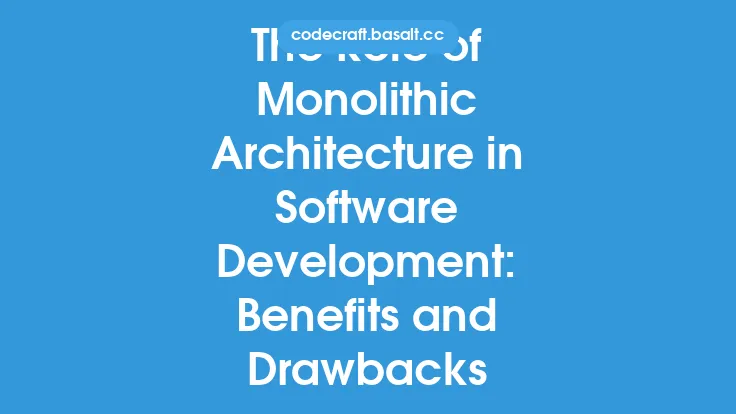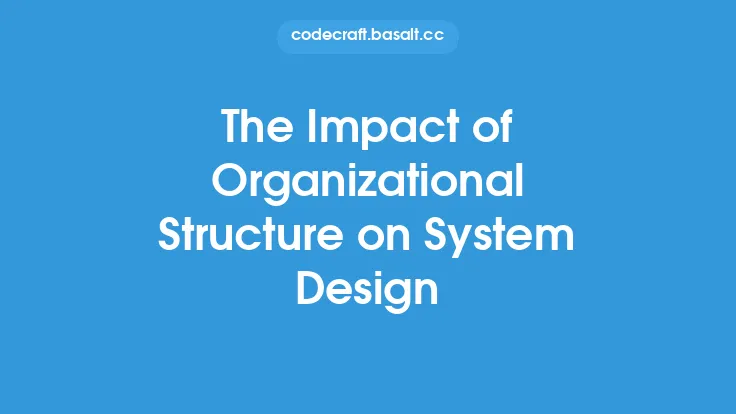The shift towards microservices architecture has significantly impacted software development teams, bringing about a change in the way they design, develop, and deploy software systems. Microservices architecture is an approach to software development that structures an application as a collection of small, independent services, each responsible for a specific business capability. This approach has gained popularity in recent years due to its ability to provide greater flexibility, scalability, and resilience compared to traditional monolithic architecture.
Introduction to Microservices and Team Structure
In a microservices-based system, each service is designed to be independent and self-contained, with its own database and communication protocol. This independence allows teams to work on individual services without affecting the entire system, enabling greater autonomy and parallelization of work. As a result, software development teams are organized around the services they develop and maintain, with each team responsible for a specific service or set of services. This structure is often referred to as a "service-oriented" team structure.
Communication and Collaboration in Microservices Teams
Effective communication and collaboration are crucial in microservices teams, as services often need to interact with each other to provide a cohesive user experience. Teams need to communicate clearly about their service's interface, data formats, and communication protocols to ensure seamless integration. This requires a high degree of coordination and cooperation among teams, which can be challenging, especially in large, distributed teams. To overcome these challenges, teams can use various collaboration tools, such as APIs, message queues, and service discovery mechanisms, to facilitate communication and data exchange between services.
Impact on Development Processes and Methodologies
The adoption of microservices architecture has also impacted software development processes and methodologies. Agile development methodologies, such as Scrum and Kanban, are well-suited for microservices development, as they emphasize iterative and incremental development, continuous delivery, and rapid feedback. Microservices teams can use these methodologies to develop and deploy individual services quickly and independently, allowing for faster time-to-market and greater responsiveness to changing business requirements. Additionally, microservices teams often adopt DevOps practices, such as continuous integration and continuous deployment (CI/CD), to automate testing, deployment, and monitoring of services, ensuring high-quality and reliable software releases.
Technical Skills and Expertise Required
Microservices development requires a range of technical skills and expertise, including programming languages, such as Java, Python, and Node.js, as well as expertise in containerization, using tools like Docker, and orchestration, using tools like Kubernetes. Teams also need to have a deep understanding of service discovery, API design, and data consistency, as well as experience with messaging queues, such as Apache Kafka or RabbitMQ, and service mesh technologies, such as Istio or Linkerd. Furthermore, microservices teams need to be proficient in monitoring and logging tools, such as Prometheus, Grafana, and ELK Stack, to ensure the health and performance of their services.
Organizational and Cultural Implications
The adoption of microservices architecture can have significant organizational and cultural implications, as it requires a shift from a traditional, hierarchical team structure to a more decentralized, service-oriented structure. This can lead to changes in team dynamics, communication patterns, and decision-making processes, which can be challenging for some organizations to adapt to. Additionally, microservices teams need to be empowered to make decisions about their services, which requires a high degree of autonomy and trust. This can lead to a more collaborative and innovative work environment, where teams are motivated to take ownership of their services and continuously improve them.
Challenges and Limitations of Microservices Teams
While microservices architecture offers many benefits, it also presents several challenges and limitations, particularly for teams that are new to this approach. One of the main challenges is the increased complexity of the system, which can make it harder to debug, test, and maintain. Additionally, microservices teams need to deal with the overhead of service discovery, communication, and data consistency, which can add complexity and latency to the system. Furthermore, microservices teams need to be aware of the potential risks of service fragmentation, where services become too fine-grained or too coarse-grained, leading to inefficiencies and scalability issues.
Best Practices for Microservices Teams
To overcome the challenges and limitations of microservices teams, several best practices can be adopted. First, teams should focus on defining clear service boundaries and interfaces, using techniques like domain-driven design (DDD) and API-first development. Second, teams should adopt a culture of continuous learning and improvement, using practices like retrospectives and feedback loops to identify areas for improvement. Third, teams should prioritize automation and tooling, using technologies like CI/CD pipelines and infrastructure-as-code (IaC) to streamline development and deployment processes. Finally, teams should emphasize collaboration and communication, using techniques like pair programming and cross-functional teams to foster a sense of shared ownership and responsibility.
Conclusion
In conclusion, the impact of microservices on software development teams is significant, requiring changes in team structure, communication, and collaboration, as well as the adoption of new technical skills and expertise. While microservices architecture offers many benefits, it also presents several challenges and limitations, which can be overcome by adopting best practices like clear service boundaries, continuous learning, automation, and collaboration. As software development teams continue to adopt microservices architecture, it is essential to prioritize the development of skills, expertise, and cultural practices that support this approach, enabling teams to deliver high-quality, scalable, and resilient software systems that meet the needs of their users.





